| |
Conventional SMPC Control
Pulse Width Modulation (PWM) is the usual means for
controlling Switched-Mode Power Converters (SMPCs).
The limits of PWM control are well understood.
Stability requires filter capacitance at the output, but
that capacitance necessarily adds a pole of filtration to
the voltage feedback.
The resulting phase lag causes PWM controls to have
a tendency toward oscillation. PWM control necessarily
involves a tradeoff between stability and agility.
PEB Provides Intrinsic Stability
Predictive Energy Balancing effectively removes
the output filter pole from the feedback path.
In the process, PEB eliminates the need to
compromise between stability and agility.
Eliminating the tendency toward sub-harmonic
behavior (and possible destructive runaway) frees
the designer to think more creatively.
The math involved is surprisingly simple, and can
be done real-time in analog or digital fashion.
The Underlying Energy Formulas
The kinetic energy held in an inductor, L, is
KEL = (I² x L) / 2
where KEL is inductive energy in joules, I is current in amps, and
L is inductance in henries.
The kinetic energy held in a capacitor, C, is
KEC = (V² x C) / 2
where KEC is capacitive energy in joules, V is voltage in volts, and
C is capacitance in farads.
At the regulation voltage, Reg, the energy in joules held
in the output filter capacitor, C, will be
KEReg = (Reg² x C) / 2
accordingly, the capacitive energy deficit at the output is
KReg - KED
The energy balance point is the moment when the inductive energy is equal to the capacitive energy deficit
KEL= KEReg - KEC
A Simple Flyback Converter
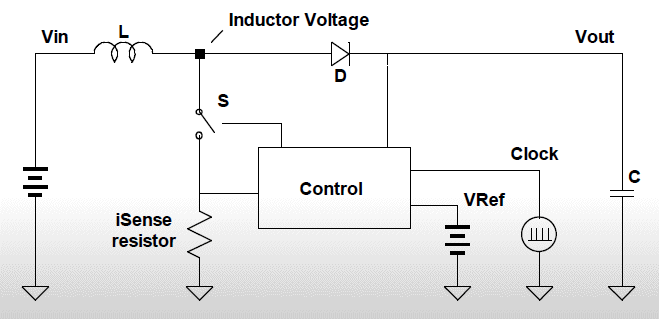 |
At the regulation voltage, and inductive energy is transferred to the output.
SPICE Waveforms
 |
The balance point is when supply and demand meet.
PEB Control Loops Show Intrinsic Stability
With the balance properly scaled, the voltage on the
filter capacitor will equal the regulation voltage after
the inductive energy transfer completes.
In this way the predictive calculation removes the
output filter pole delay from the feedback loop.
Each control cycle becomes a self-contained operation,
not reliant on previous conditions.
Excellent transient response, without sub-harmonic
behavior, is the direct result.
PEB allows use of theoretic minimum value filter capacitor.
Practical Demonstration
This demonstration board is a simple flyback PEB converter producing 5 volts from a 1.5 volt
battery.
The additional circuitry added to implement PEB occupies about 0.2 square inches.
|
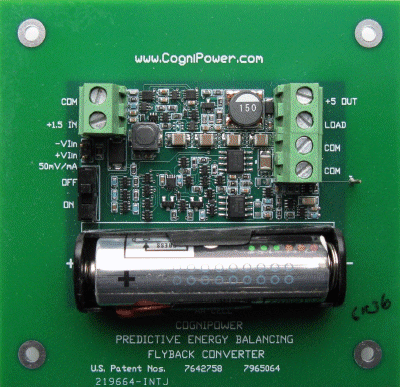 |
Predictive Energy Balancing Demo Schematic
 |
The converter and calculation circuitry is implemented
here using discrete analog components with a very few
logic chips. The design is aimed at easy integration.
Screen Shot Showing Output Regulation
Upper trace, load current at 10 mA/div
Time scale, 20žs/div
Lower trace, output voltage at 10 mV/div
|
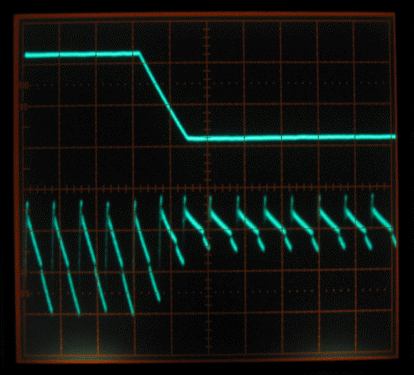 |
Generalization of PEB Controls
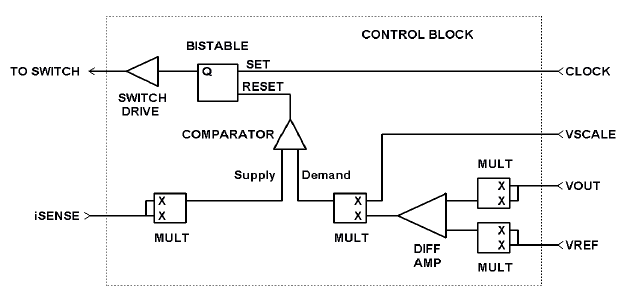 |
A generalized circuit block can perform the Energy
Balancing calculation for a variety of SMPCs.
Bipolar Bidirectional Power Amplifier
 |
An SMPC that can follow a changing reference is a form of amplifier.
Power Amplifier SPICE Output
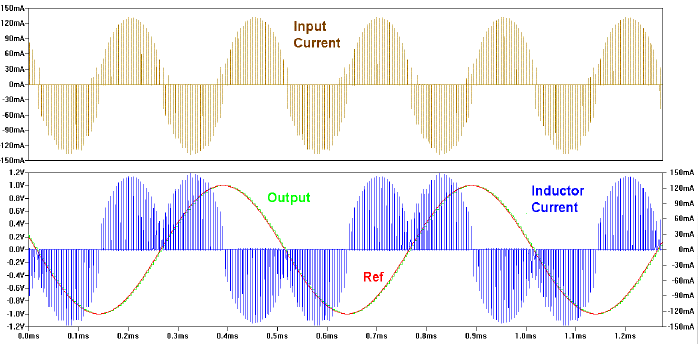 |
A bipolar output is generated from a unipolar input.
Unprecedented Efficiency
Note that the average current at the power input in
the previous slide approaches zero when driving a
capacitive load.
Energy is alternately moved from input to output,
then, from output to input.
If the power converter is 90% efficient in both
directions, .9 x .9 = .81, so up to 81% of the power
for an AC output cycle could be recovered and reused.
Why Hasn't This Amp Been Built Before?
To make such an efficient amplifier practical, Predictive
Energy Balancing is the essential element.
Without PEB's ability to steer an SMPC output voltage
(with a reactive load) to hit a moving target on the first
try, such an amplifier would be unmanageable.
This amp is covered by four issued CogniPower Patents.
As a bonus, these amplifiers incorporate active
termination, that is, they inherently damp resonances
and reflections at their outputs.
Audio Amplifier, a Related Application
 |
Audio amplifier to drive a cell phone piezo (or dynamic)
speaker more efficiently from a 4 volt battery.
Audio Amp SPICE Output
 |
A few ms of music: Output trace hidden by Input trace.
Cell Phone Audio Amplifier Advantages
The audio amp efficiently produces AC output from a
single, unregulated power rail.
The power input current averages to near zero.
Input and output traces are almost indistinguishable.
Self-termination flattens the response curve, even with
a piezo speaker having a strong resonant peak.
This bidirectional amplifier can harvest ambient energy
from a piezo speaker for charging the battery.
Control Block for PEB Amplifier or SMPC
 |
A volt time product can replace a sensed inductor current.
Other Applications
Point of Load Converters
LED Lighting
Electric Vehicles
Smart Grid
Computers and File Servers
Solar Inverters
AC-AC Converters
|
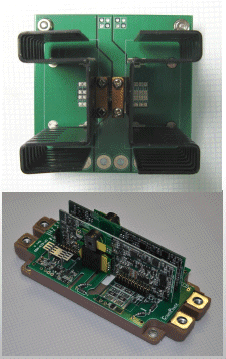 |
Related Power Converter Development
CogniPower is developing an AC-DC topology that
performs Power Factor Correction and agile output
regulation in which the majority of power moves
through only a single stage of power conversion.
Better efficiency and smaller size result.
A battery charger is also in development. Better
regulation allows much smaller filter capacitors, so
that small, inexpensive ceramic capacitors can replace
larger electrolytic or tantalum parts. Cost and size are
reduced while performance and efficiency increase.
Questions?
CogniPower holds six issued patents, including two
fundamental patents covering Predictive Energy Balancing.
Many more patents are in process for SMPC building
blocks, controls, and topologies.
Predictive Energy Balancing enables more capable power
converters that combine stability, agility and efficiency.
Most SMPCs don't have to make music, but extra
responsiveness may provide the crucial margin of safety.
Please visit www.cognipower.com for more information.

|
|
CogniPower has developed and patented radical technology aimed primarily at improving power
supplies. A side benefit of this new technology is the ability to make fundamentally different
audio amplifiers which are more efficient and sound better than conventional amplifiers. The
improved efficiency is particularly valuable for any audio device that runs on batteries, because it
extends battery life.
Cell phones and tablet computers are known for crisp displays and horrible sound. Our audio
amplifiers can greatly improve both their efficiency and fidelity. The experience of watching a
movie on a tablet computer could be vastly better with good sound and longer battery life.
Furthermore, in noisy environments, like airplane cabins, sound energy can be harvested to
recharge the battery.
How is it possible? In a conventional audio amplifier, all the energy moves from the power supply
to the speaker. We draw some of the energy back from the speaker and reuse it, instead of
dissipating it as wasted heat. Two distinct new technologies are necessary to make that approach
practical, which is why it has not been done before. CogniPower holds fundamental, issued patents
on both those technologies. A predictive, bidirectional power converter drives the speaker directly,
eliminating the size and cost of extra power supplies. This bidirectional amplifier approach
actually makes a given speaker sound better, and enables the design of even more efficient
speakers.
High fidelity speakers require enclosures which must damp resonances to avoid peaks and valleys
in the sound at different frequencies. The CogniPower audio amplifier removes those peaks and
valleys actively, by recovering energy. The conventional, passive damping methods that waste
power become unnecessary. Also, ceramic or electrostatic speakers are more efficient, but are hard
to drive using conventional amplifiers. The CogniPower amplifier can recover even more energy
from these types of speakers, for further efficiency improvements. Battery drain can be reduced by
a factor of five to ten compared to conventional efficient amplifiers.
These improvements are achieved via a rearrangement of the same circuit elements now employed
in conventional efficient audio amplifiers, with the addition of a novel means of control. Since
changing the control intelligence does not add to the cost of an integrated circuit, these benefits
can be realized without an increase in cost. System costs can be reduced because less waste heat
needs to be removed, and a smaller battery can perform the same job.
The same technology can be scaled for hearing aids, or consumer electronics, all the way up to
theater-sized systems.
| |
 |
3217 Phoenixville Pike |
Malvern, PA 19355 |
www.cognipower.com |
|
|
|














